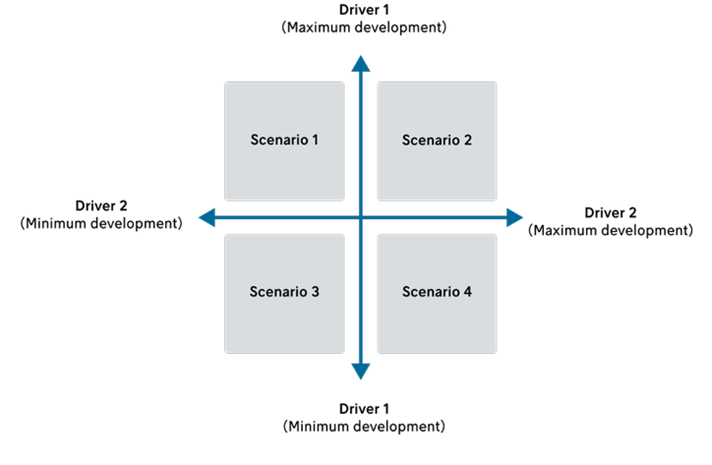Introduction
The multi-scenario generation technique creates a 2x2 matrix very good for scenario generation and decision making. In this technique, a 2x2 matrix is created to represent possible scenarios by mapping two important drivers or factors on the axes. The technique aims to assess the impact of different scenarios on the issue under consideration, providing a framework for evaluating policy options. The 2x2 matrix helps identify uncertainties and allows decision-makers to test policies for medium and long-term planning.
2x2 Matrix
The Multi scenario generation technique is also known as scenario planning, scenario thinking, scenario analysis, scenario prediction, and the scenario method. It is used with the 2x2 matrix that is also known as 2x2 Decision matrix or Four blocker or magic quadrant.
Description
What is the technique about:
The 2x2 scenario matrix is one of the most common and preferred scenario planning templates. The model creates simple, fast, striking, and informative scenarios using key drivers and uncertainties. It generates scenarios in areas such as product and service development, strategy, and risk management (Rhydderch, A. 2017).
For which purposes is it used:
For the 2x2 matrix technique, scenarios describe events over a medium to long-term time frame. They envision how certain trends and events that may occur will make changes. They usually construct two to five scenarios to represent different possible future scenarios associated with a range of trends and events. In this way, it generates up to four contrasting scenarios related to a particular area of interest (geographic or thematic) by placing two factors affecting the future of the subject on two intersecting axes to form four quadrants (Rhydderch, A. 2017).
Limitations:
There are also disadvantages of the 2x2 matrix technique. It does not accommodate the interaction between many variables. Moreover, situations may arise where it does not integrate stable trends and gradual developments, as it focuses on key uncertainties. There may be times when several other factors need to be compared for a full assessment of the situation.
How to implement these technique/tools
By utilizing this technique, students can gain practical insights into the complexities of entrepreneurship and develop critical thinking skills in evaluating and adapting their business plans. It promotes a proactive mindset, strategic thinking, and the ability to make informed decisions in the face of uncertainties, all of which are valuable in entrepreneurial education.
Preparation, before the session:
- Identifying Key Factors: Select two important factors or drivers that have a significant impact on entrepreneurial success or business planning. For example, these factors could be market demand, competition, technology, customer preferences, or economic conditions.
During the session:
- Creating Scenarios: Use the 2x2 matrix to create different scenarios by plotting the identified factors on the axes. This will help students visualize and explore various combinations of these factors that could affect entrepreneurial ventures or business decisions.
- Analysing Impact: Discuss with students the implications of each scenario by considering the interactions between the factors. Encourage them to evaluate the potential risks, opportunities, and challenges associated with each scenario.
- Students must discuss the key internal dynamics influencing it.
- Identify driving forces in the environment. Ask the students to reflect about the dynamics behind the internal.
- Suggest students to rank driving forces by importance and uncertainty. Going through the forces one by one, students should discuss how important each one is to the focal issue. (There are several possibilities for ranking, including using an intuitive 1-10 or a low/medium/high scale.)
- Policy and Decision Testing: Encourage students to develop entrepreneurial policies or strategies that align with each scenario. By testing their policies within different scenarios, students can assess the effectiveness and feasibility of their decisions in different business environments.
- Group Discussion and Adaptation: Foster group discussions to encourage diverse perspectives and collective decision-making. Emphasize the importance of flexibility and adaptability in response to changing scenarios and market conditions.
- Speed and Agility: Highlight the significance of quick decision-making and the ability to respond promptly to emerging opportunities or challenges. Teach students to assess the dynamic nature of the business environment and adjust their strategies accordingly.
- By developing scenarios, participants create a set of different paths along which the present situation may evolve, as well as a final destination.
Follow-up after the session:
- Facilitate reflective discussions where students can share their experiences and insights gained.
- Engage in post-session discussions or individual conferences with students to address any questions or concerns and provide feedback.
Examples and/or testimonials

From: https://www.futuresplatform.com/blog/2x2-scenario-planning-matrix-guideline
Tools needed
In most cases, no special preparation is required. The students will bring their ideas, knowledge, and experience. Ordinary classroom tools and equipment are needed, e.g., enough space, basic office supplies (flipchart, felt-tip pens, sticky notes), simple audio-visual equipment.
Resources
Links:
- https://www.benchmarksixsigma.com/forum/topic/39325-2x2-matrix/
- https://www.futuresplatform.com/blog/2x2-scenario-planning-matrix-guideline
Videos:
Papers:
- Rhydderch, A. (2017). Scenario Building: The 2x2 Matrix. Futuribles. Retrieved from https://www.futuribles.com/en/group/prospective-and-strategic-foresight-toolbox/document/scenariobuilding-the-2x2-matrix-technique.
- Wang, C. (2017, June). Teaching entrepreneurial mindset in a first-year introduction to engineering course. In 2017 ASEE Annual Conference & Exposition.
- Rhydderch, A. (2017). Scenario Building: The 2x2 Matrix. Futuribles. Retrieved from https://www.futuribles.com/en/group/prospective-and-strategic-foresight-toolbox/document/scenariobuilding-the-2x2-matrix-technique.
- Wang, C. (2017, June). Teaching entrepreneurial mindset in a first-year introduction to engineering course. In 2017 ASEE Annual Conference & Exposition.
Books:
- Terras, A. (1999). Fourier analysis on finite groups and applications(No. 43). Cambridge University Press.
- Zhang, F. (2005). Block matrix techniques. The Schur complement and its applications, 83-110.